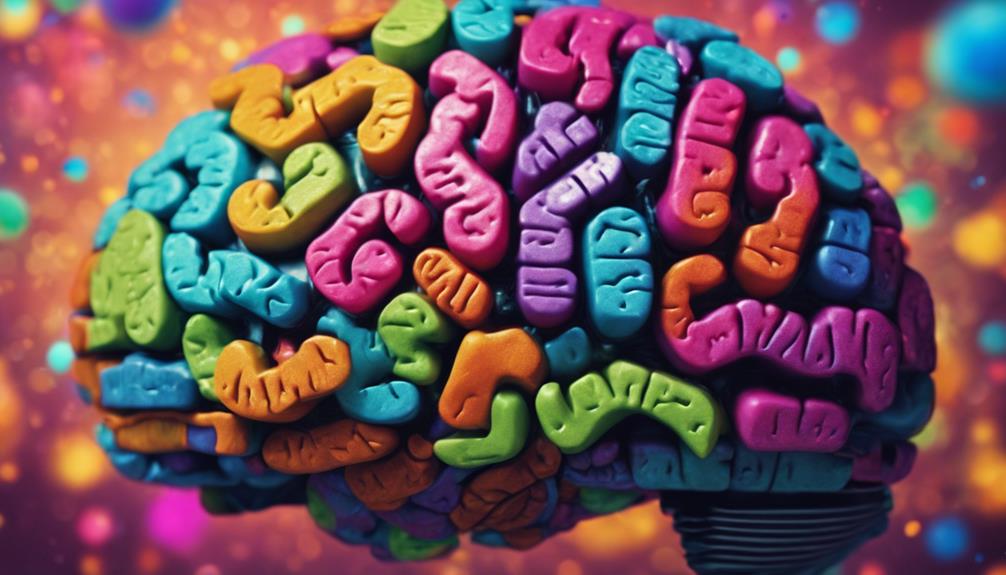Learning figurative language is essential as it enhances our communication skills, fosters deeper connections with others, and promotes critical thinking. Understanding figures of speech helps us express abstract ideas vividly and appreciate diverse cultures more effectively. By mastering figurative language, we enrich our reading comprehension, engage with texts on a profound level, and grasp underlying messages and emotions with clarity. Additionally, it nurtures our language development, expands our cognitive abilities, and enables us to express complex ideas persuasively. Embracing figurative language not only improves our language skills but also broadens our perspectives and fosters a deeper appreciation for the beauty of language and culture.
Key Takeaways
- Enhances language fluency and comprehension skills.
- Sparks creativity and critical thinking in communication.
- Deepens reading comprehension and emotional connections.
- Reflects cultural diversity and fosters inclusivity.
- Enables vivid expression of complex ideas persuasively.
Importance of Figurative Language
Understanding figurative language enhances our reading comprehension skills by imbuing texts with depth and nuance. Teaching students to understand figurative language is vital for their overall language development. By delving into the world of figurative language, students can grasp abstract ideas more effectively. Through exposure to idioms, adages, and proverbs, students not only enhance their language fluency but also navigate cultural expressions and common phrases for better communication.
Figurative language serves as a bridge to connect students with the subtleties of a language, enabling them to interpret texts more profoundly. It lays the groundwork for students to express themselves in a more vivid and imaginative manner. By learning figurative language, students gain a deeper appreciation for the nuances of communication, allowing them to engage more meaningfully with a wide range of literary works. Ultimately, teaching figurative language empowers students to become more effective communicators and critical thinkers.
Enhancing Communication Skills

Exploring the domain of figurative language not only enriches our communication skills but also fosters creativity and engaging dialogues. Understanding and using figurative language is essential for enhancing communication skills.
Here are four ways in which figurative language can help improve our ability to communicate effectively:
- Enhanced Expression: Figurative language allows us to express ideas in a more vivid and imaginative way, making our communication more engaging and memorable.
- Improved Understanding: By mastering figurative language, we can better understand the nuances of language and interpret the intended meanings behind words, leading to more effective communication.
- Creative Conversations: Using figurative language in conversations can spark creativity, encourage active listening, and promote deeper connections with others.
- Critical Thinking: Incorporating figurative language in our communication requires us to think critically about language usage, leading to more precise and impactful expressions of our thoughts and ideas.
Enriching Reading Comprehension

Exploring figurative language enriches our engagement with texts, nurturing a deeper connection with the content and enhancing our reading comprehension. By comprehending figurative language, readers can grasp the underlying messages and emotions conveyed by the author. This understanding goes beyond the literal words on the page, allowing us to delve into the subtleties and nuances of the text.
When we're able to identify similes, metaphors, and other forms of figurative language in literature, we gain insight into the author's intended meaning. This deeper understanding enables us to appreciate the work on a more profound level, connecting with the themes and ideas presented.
Teaching figurative language not only enriches reading comprehension but also promotes critical thinking and analysis. It challenges readers to go beyond surface-level interpretations, fostering a more profound engagement with the text. As we develop proficiency in figurative language, we reveal the richness and complexity of language, leading to a more fulfilling and enjoyable reading experience.
Cultural Relevance and Nuances

Understanding the cultural nuances in figurative language is crucial for appreciating the diversity of societies and their unique expressions.
Figurative language not only reflects regional differences but also fosters a deeper understanding of various cultural beliefs and traditions.
Cultural Nuances in Language
Embracing the cultural nuances embedded within language enriches our ability to connect with diverse groups effectively. Understanding figurative language goes beyond words; it involves delving into the cultural roots of expressions.
Here are four key reasons why cultural nuances in language are crucial for mastery:
- Insight into Society: Idioms and metaphors reveal societal values and beliefs.
- Cultural Diversity: Figurative language reflects heritage, fostering appreciation.
- Respect and Empathy: Recognizing cultural references promotes understanding and respect.
- Cross-Cultural Communication: Learning cultural nuances enhances inclusivity and effective communication.
Relevance to Diverse Societies
Exploring the cultural relevance and nuances of figurative language opens doors to deeper connections and understanding in diverse societies. Teaching idioms and cultural references is essential for English language learners to grasp the subtleties of expression.
Understanding figurative language helps in navigating social interactions and promoting cross-cultural communication. Cultural relevance in figurative language fosters respect and appreciation for different traditions and values, enriching societal connections.
Nuances in idiomatic expressions reflect the diverse linguistic tapestry of global communities, showcasing the beauty of varied languages. Embracing these nuances not only enhances language proficiency but also cultivates empathy and awareness of cultural diversity.
Essentially, figurative language serves as a gateway to bridging cultural divides and fostering mutual understanding among diverse societies.
Understanding Regional Expressions
Regional expressions offer a unique insight into the cultural diversity and historical influences present within specific geographic areas. When exploring regional expressions, we can enhance our cultural awareness and develop a deeper appreciation for the nuances embedded in these linguistic gems.
Here are four reasons why understanding regional expressions is important for effective communication and connection:
- Cultural Awareness: Regional expressions provide a window into the values, customs, and traditions of a particular geographic area.
- Communication Enrichment: Learning regional expressions can deepen our connections with individuals from diverse backgrounds.
- Unique Meanings: These expressions often carry meanings and nuances specific to a region or community.
- Historical Insight: Regional expressions reflect the historical influences that have shaped a region's language and culture.
Enhancing Language Development

Enhancing language development through the study of figurative language is fundamental for fostering critical and creative thinking skills in students. By delving into the intricacies of figurative language, learners not only expand their linguistic capabilities but also enhance their overall cognitive skills. Understanding different types of figurative language, such as similes, metaphors, and personification, allows students to engage with language on a deeper level, enabling them to express complex ideas more vividly and persuasively.
Exploring figurative language not only improves communication skills but also nurtures a deeper comprehension of abstract concepts. This deeper understanding is essential for interpreting literature effectively and articulating thoughts with clarity and precision. Additionally, mastering figurative language plays a pivotal role in enhancing language fluency, benefiting students in both their reading and writing endeavors. By immersing themselves in the world of figurative language, students can discover new avenues for linguistic growth and cognitive development.
Impact on Language Learning

Our exploration of figurative language's impact on language learning reveals its significant role in enhancing vocabulary acquisition and comprehension skills while fostering creativity and critical thinking abilities in learners.
When engaging with figurative language, learners benefit in several key ways:
- Enhanced Vocabulary Acquisition: Exposure to various forms of figurative language introduces learners to new words and expressions, expanding their lexicon beyond literal meanings.
- Improved Comprehension Skills: Decoding figurative language requires deeper understanding and analysis, which in turn enhances overall comprehension skills in language learners.
- Fostering Creativity: Figurative language prompts learners to think imaginatively and creatively, encouraging them to explore different interpretations and meanings beyond the surface level.
- Developing Critical Thinking Abilities: By deciphering figurative language in context, learners hone their critical thinking skills as they analyze and interpret language nuances, leading to a more profound understanding of linguistic subtleties.
In essence, figurative language serves as a catalyst for holistic language learning, nurturing not only linguistic proficiency but also cognitive skills essential for effective communication.
Expressing Abstract Ideas

Utilizing figurative language enables us to creatively express abstract ideas through vivid comparisons and imagery. By exploring figurative language, we can delve into the deeper meanings of words and convey complex concepts with more depth and richness. The use of figurative language enhances our ability to communicate intangible thoughts and emotions effectively, adding layers of meaning to our expressions.
When expressing abstract ideas, figurative language allows us to paint a more vibrant picture for our audience, helping them grasp intricate concepts that may be challenging to explain literally. Through the use of metaphors, similes, and other forms of figurative speech, we can convey emotions, experiences, and philosophical thoughts in a more engaging and relatable manner.
Mastering figurative language not only enriches our communication skills but also opens doors to a world of creativity and nuanced expression. It enables us to engage in more profound conversations and explore the subtleties of human experience, making our interactions more meaningful and thought-provoking.
Enhancing Creative Writing

Figurative language enriches our creative writing by painting vivid pictures with words, allowing us to express complex emotions and thoughts in a more engaging manner.
It helps us create memorable and impactful pieces by using similes, metaphors, and personification to add depth and uniqueness to our work.
Writing With Imagery
Enhancing creative writing with vivid imagery through the use of figurative language elevates the reader's experience and captivates their imagination.
When writing with imagery, consider these key points:
- Similes and Metaphors: Comparing two unlike things using 'like' or 'as' (simile) or stating one thing is another (metaphor) creates powerful visual connections.
- Personification: Giving human qualities to non-human entities can make descriptions more engaging and relatable.
- Hyperbole: Exaggerating for effect can add drama and emphasis to your writing.
- Onomatopoeia: Using words that imitate sounds can bring scenes to life and make them more immersive.
Expressing Emotions Creatively
Moving from the exploration of vivid imagery in writing, we now shift our focus towards creatively expressing emotions through the power of language.
By using various types of figurative language such as metaphors, similes, and personification, writers can effectively convey abstract ideas and complex emotions in their work.
The benefits of teaching figurative language extend to enhancing creative writing skills, allowing for a deeper connection with readers and a more impactful storytelling experience.
Through mastering the art of figurative language, individuals can infuse their writing with depth, originality, and resonance, making their narratives more compelling and memorable.
Understanding and utilizing figurative language not only adds richness to writing but also enables writers to evoke powerful emotional responses and convey nuanced experiences effectively.
Benefits for Language Learners

Engaging with figurative language enriches our understanding of English idioms and expressions, fostering a deeper connection to the language and culture. Here are four benefits for language learners:
- Enhanced Comprehension: Figurative language enhances our ability to grasp the meaning behind idiomatic expressions, making it easier to communicate effectively in English.
- Cultural Appreciation: Understanding figurative language allows language learners to appreciate the cultural nuances embedded in English, leading to a more profound connection with the language and its speakers.
- Improved Communication Skills: Regular practice with figurative language sharpens communication skills and boosts language fluency, helping language learners express themselves more eloquently.
- Critical Thinking Development: Engaging in figurative language activities promotes critical thinking and creativity in language use, enabling learners to think beyond literal meanings and explore language in a more nuanced way.
Frequently Asked Questions
Why Is It Important to Understand Figurative Language?
Understanding figurative language is essential for grasping hidden meanings and enhancing critical thinking skills. It adds depth to texts, making them more engaging and aids in expressing abstract ideas effectively. However, many readers may struggle with interpreting subtle nuances, which is why figurative language is difficult for some to fully understand. This challenge stems from the fact that figurative expressions often require drawing connections between seemingly unrelated ideas or concepts. Despite this complexity, mastering figurative language can lead to a richer and more nuanced comprehension of both literature and everyday communication. Additionally, figurative language often varies across cultures, making it even harder for readers to decipher without cultural context or familiarity. This further highlights **why figurative language is difficult** for some individuals, as it demands a combination of knowledge, intuition, and experience to interpret correctly. Nevertheless, developing an understanding of such language can greatly enhance one’s ability to appreciate the full range of meaning and emotion in both spoken and written forms.
Mastery of figurative language allows for a deeper analysis of literary works, enriching our comprehension and interpretation. Overall, it's important to comprehend figurative language to fully appreciate the complexities and nuances of communication and written works.
How Does Figurative Language Help You as a Student?
Understanding figurative language helps us as students by enhancing our critical thinking skills and fostering creativity. It allows us to make deeper connections with texts, analyze complex ideas, and appreciate literature on a deeper level.
Proficiency in figurative language not only improves our comprehension but also boosts our academic performance by enhancing our language and communication skills. In essence, figurative language is a powerful tool that enriches our learning experience.
How Do We Use Figurative Language in Our Daily Living?
In our daily lives, we use figurative language to enhance communication. Similes and metaphors help convey complex ideas in engaging ways. Personifying objects or animals makes descriptions vivid. Incorporating idioms and proverbs conveys cultural wisdom effectively.
Recognizing and using figurative language fosters a deeper understanding of language nuances. By incorporating these elements into our conversations, we enrich our interactions and make our communication more expressive and relatable.
What Are the Benefits of Learning Figures of Speech?
Learning figures of speech offers numerous benefits. It enhances creativity, deepens comprehension, and fosters critical thinking.
Mastery of figurative language adds richness to writing and makes it more engaging. Understanding figures of speech improves critical reading skills and enhances communication.
Conclusion
To sum up, endeavor to enhance communication skills, enrich reading comprehension, and express abstract ideas effectively.
It plays a significant role in language development, creative writing, and cultural understanding.
By mastering figurative language, we can better convey complex emotions and concepts in a more engaging and nuanced manner.
So, why not work towards improving our language skills by embracing the power of figurative language?











